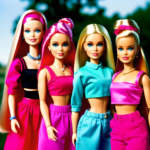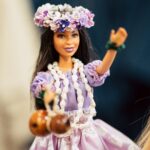
Barbie, a beloved icon in the world of toys, has undergone a remarkable transformation over the years to embrace diversity and inclusivity. Through changes in doll shapes, skin tones, and hairstyles, Barbie now reflects a more accurate representation of the world we live in. The once stereotypical image of a thin, blonde-haired, blue-eyed doll has made way for a range of body types, ethnicities, and cultural backgrounds. This evolution has not only empowered young girls to see themselves in the dolls they play with, but it has also sparked a larger conversation about the importance of representation in the media and beyond.

This image is property of images.unsplash.com.
Early history of Barbie
Creation of Barbie by Ruth Handler
Barbie, the iconic doll that has captured the hearts of millions of children around the world, was created by Ruth Handler in the 1950s. Inspired by her daughter’s fascination with paper dolls, Handler envisioned a three-dimensional doll with adult features. She recognized the need for a doll that could inspire imaginative play, encourage dreams, and reflect the changing times.
First Barbie doll released in 1959
In 1959, the first Barbie doll was introduced to the world at the American International Toy Fair in New York. With her fashionable outfits, signature blonde ponytail, and stylish accessories, Barbie became an instant sensation. She embodied a sense of independence, sophistication, and adventure, which was a departure from the traditional baby dolls prevalent at the time. Barbie’s popularity soared, inspiring countless young minds to dream big and set their sights on the possibilities that lay ahead.
Early criticism of Barbie’s lack of diversity and inclusivity
However, as the years went by, concerns arose about Barbie’s lack of diversity and inclusivity. Critics argued that Barbie’s representation was limited, both in terms of ethnicity and body image. The doll primarily showcased a specific standard of beauty that did not reflect the diversity found in society. These critiques led to a shift in Barbie’s trajectory, fostering change and paving the way for a more inclusive future.
Introduction of diverse friends and family
1963: Introduction of first African American friend, Francie
Mattel, the company behind Barbie, recognized the importance of diversity and inclusivity, and in 1963, Francie, Barbie’s first African American friend, was introduced. This marked a significant milestone in Barbie’s journey towards representation. Francie brought a fresh perspective and offered young girls a relatable role model with whom they could identify. Her presence broadened the narrative and encouraged a more inclusive understanding of beauty and friendship.
1980s: Introduction of Hispanic and Asian friends
In the 1980s, Barbie continued to expand her circle of friends with the introduction of Hispanic and Asian dolls. These new additions celebrated the vibrant cultures and traditions of these communities, providing young girls with dolls that reflected their own heritage and backgrounds. Through these diverse friendships, Barbie taught generations about the value of embracing different cultures and fostering inclusivity.
1990s: Introduction of Barbie’s sister, Skipper
The 1990s witnessed yet another pivotal moment in Barbie’s evolution. Barbie’s sister, Skipper, was introduced, becoming an important character in the Barbie universe. Skipper represented a relatable sibling bond, allowing children to explore themes of family, friendship, and growth. This inclusion expanded the narrative possibilities and enhanced the overall richness of Barbie’s world.
Expansion of career options
1960s-1970s: Barbie explores various career paths
During the 1960s and 1970s, Barbie embarked on a journey of career exploration. She became an astronaut, doctor, teacher, and more, breaking gender stereotypes and inspiring girls to dream big. By showcasing a range of professional roles, Barbie encouraged young minds to envision themselves in non-traditional careers, highlighting the importance of equality and empowering girls to pursue their passions.
1990s: Barbie becomes a working woman
In the 1990s, Barbie took her career to new heights by embracing the role of a working woman. She became a businesswoman, showing young girls that they could excel in the professional world. This shift brought forth the message that women can be ambitious, independent, and successful in various spheres of life.
2000s: Barbie represents diverse and inclusive careers
As we entered the 2000s, Barbie’s commitment to diversity and inclusivity extended to her career choices. Barbie took on roles that represented a broader range of professions, including engineers, computer programmers, and athletes. By highlighting the accomplishments of women in traditionally male-dominated fields, Barbie shattered glass ceilings and inspired young girls to challenge societal expectations.
Body image and diversity
Modifications to Barbie’s body proportions
Recognizing the need for change, Mattel responded to concerns about Barbie’s unrealistic body proportions. In 2016, Barbie underwent a transformation, with the introduction of curvy, petite, and tall dolls. This breakthrough celebrated diverse body types and sent a powerful message that beauty comes in all shapes and sizes. These modifications reflected a more realistic representation of women and served as a reminder that every individual’s uniqueness should be celebrated.
2016: Introduction of curvy, petite, and tall Barbie dolls
The introduction of curvy, petite, and tall Barbie dolls in 2016 was a significant step towards promoting body positivity and empowering individuals to love and embrace their bodies. This move aimed to instill confidence in young girls and challenge narrow beauty standards. The expanded range of body types allowed for greater inclusivity and ensured that girls from all backgrounds could feel represented and acknowledged.
Representation of different ethnicities and skin tones
Barbie’s journey of diversification includes not only her body image but also her representation of different ethnicities and skin tones. Over the years, Barbie dolls have been released in a range of skin tones that reflect the beautiful diversity found in society. By mirroring the world around them, these Barbie dolls serve as powerful tools for teaching children the importance of inclusivity, empathy, and acceptance of others.

This image is property of images.unsplash.com.
Collaborations and partnerships
Limited-edition Barbie dolls paying tribute to influential individuals
Barbie has collaborated with numerous influential individuals to create limited-edition dolls that celebrate diverse role models and their contributions. These dolls pay tribute to women who have excelled in various fields, including sports, arts, science, and journalism. By honoring these remarkable individuals, Barbie amplifies their achievements and encourages young girls to pursue their dreams fearlessly.
Partnerships with organizations focusing on inclusivity and diversity
In its commitment to inclusivity and diversity, Barbie has formed partnerships with organizations working towards these ideals. Collaborations with organizations such as UNICEF and the Special Olympics have resulted in doll lines that promote awareness, participation, and acceptance of individuals with disabilities. These partnerships have elevated Barbie’s social impact, fostering empathy and breaking down barriers.
Dolls inspired by cultural heritage and celebrations
Barbie’s collaborations also extend to celebrating cultural heritage and traditional celebrations. Dolls inspired by world cultures and festivals have served as educational tools, teaching children about different customs, traditions, and the beauty of diversity. By embracing and showcasing a wide variety of cultural backgrounds, Barbie continues to encourage inclusivity and intercultural understanding.
Empowerment and social impact
Barbie’s role in promoting empowerment and breaking stereotypes
Barbie has played a crucial role in promoting empowerment and breaking stereotypes throughout her evolution. By showcasing diverse career options, encouraging ambition, and challenging societal norms, Barbie has become an inspiration for countless young girls. She embodies the belief that girls can be anything they set their minds to, instilling the confidence and self-belief necessary to overcome obstacles and pursue their aspirations.
Representation of diverse abilities and body types
Barbie’s commitment to inclusivity extends to representing diverse abilities and body types. Dolls with assistive devices, such as wheelchairs and prosthetic limbs, have been introduced, providing children with a more accurate reflection of the world around them. These dolls help foster empathy, understanding, and validation for individuals with disabilities, enabling young minds to celebrate and embrace diversity.
Campaigns and initiatives for positive social change
Barbie has launched several campaigns and initiatives aimed at driving positive social change. These campaigns tackle various issues, ranging from body confidence to bullying prevention. Barbie’s online presence and social media platforms have been utilized to spread awareness, inspire conversation, and empower young individuals to make a difference. Through these efforts, Barbie amplifies voices, raises important questions, and encourages dialogue around important societal issues.

This image is property of images.unsplash.com.
Response to criticism and challenges
Acknowledgment of past shortcomings
Mattel and Barbie have acknowledged their past shortcomings and the criticism directed towards them. They have recognized the importance of diversity and inclusivity, admitting that there were areas where Barbie fell short in representing the diverse world she aimed to inspire. This acknowledgment sparked a renewed commitment to listening, learning, and taking the necessary steps to ensure a more inclusive future for Barbie.
Ongoing efforts to improve diversity and inclusivity
In response to criticism, Mattel has made ongoing efforts to improve Barbie’s diversity and inclusivity. They have actively sought feedback from consumers and worked to implement changes that address concerns and promote inclusiveness. By engaging with communities, organizations, and experts, Mattel strives to ensure that Barbie remains a reflection of the ever-evolving world and a source of inspiration for generations to come.
Commitment to continuous evolution and learning
Barbie’s journey towards diversity and inclusivity is an ongoing commitment. Mattel recognizes the need for continuous evolution and learning. They are dedicated to keeping their finger on the pulse of societal progress, staying attuned to the voices and perspectives of children, parents, and advocates. By remaining open to feedback, embracing challenges, and committing to growth, Barbie will continue to evolve and represent the values of diversity, inclusivity, and empowerment.
Barbie in the digital age
Digital play experiences promoting diversity and inclusivity
Barbie has adapted to the digital age by embracing technology and creating innovative, interactive play experiences. Digital platforms and apps encourage creativity, imagination, and problem-solving skills, while also promoting diversity and inclusivity. Through these digital play experiences, Barbie aims to engage with children in an immersive and educational way, fostering an understanding of the importance of acceptance and empathy.
Expansion into online platforms, apps, and games
To reach a wider audience and cater to the tech-savvy generation, Barbie has expanded her presence into online platforms, apps, and games. These platforms provide children with opportunities to engage in virtual play, explore careers, and interact with Barbie and her diverse friends. By incorporating diversity and inclusivity into these digital spaces, Barbie continues to connect with children in meaningful ways, empowering them to embrace their unique identities and appreciate the differences of others.
Representation of diverse characters and stories
In the digital age, Barbie continues to represent diverse characters and tell inclusive stories. From animated series to online content, Barbie showcases narratives that highlight multicultural experiences and celebrate diverse identities. By expanding the range of voices and stories, Barbie encourages children to develop empathy, tolerance, and a genuine appreciation for the beauty of diversity.
The future of Barbie
Innovations and advancements in diversity and inclusivity
The future of Barbie holds great promise for further innovations and advancements in diversity and inclusivity. With each passing year, Mattel demonstrates a commitment to evolving and responding to the changing needs of its audience. By incorporating cutting-edge technology, research, and continuous feedback, Barbie will continue to push boundaries and redefine what it means to be diverse, inclusive, and empowering.
Anticipation for ongoing growth and improvements
As we look to the future, there is great anticipation for ongoing growth and improvements in Barbie’s journey towards diversity and inclusivity. The world is constantly evolving, and Barbie has shown her ability to adapt and respond to societal changes. With eyes on the horizon, we can expect Barbie to captivate and inspire the next generation with her continued commitment to dynamism, inclusivity, and empowerment.
Barbie’s role in inspiring the next generation
Barbie’s impact on generations of children cannot be overstated. As she continues to embrace diversity, challenge norms, and inspire girls to dream big, she will undoubtedly play a vital role in shaping the next generation. Through representation, empowerment, and compassion, Barbie serves as a beacon of possibility, encouraging children to believe in themselves, celebrate their unique qualities, and strive for a future where everyone is embraced, respected, and included.
Conclusion
Barbie’s evolution over the years reflects a genuine commitment to diversity and inclusivity. From her creation by Ruth Handler to her current status in the digital age, Barbie has continuously adapted and responded to societal demands. Through the introduction of diverse friends and family, the expansion of career options, and the representation of various body types and ethnicities, Barbie has become a powerful symbol of empowerment and social impact. As Barbie looks toward the future, we can expect her to remain a powerful force in inspiring the next generation and paving the way for a world that celebrates diversity, inclusivity, and the boundless potential of every individual.










